
The nights are becoming cooler and definitely shorter. Insects of all sorts – bees, wasps, beetles, ladybugs, aphids, butterflies, moths, and caterpillars — are flitting, creeping, chomping, and pollinating our native plants as foliage browns and flowers fade. Chipping and white-crown sparrows along with juncos flush up from meadows as we hike through. They have been feasting on seeds.
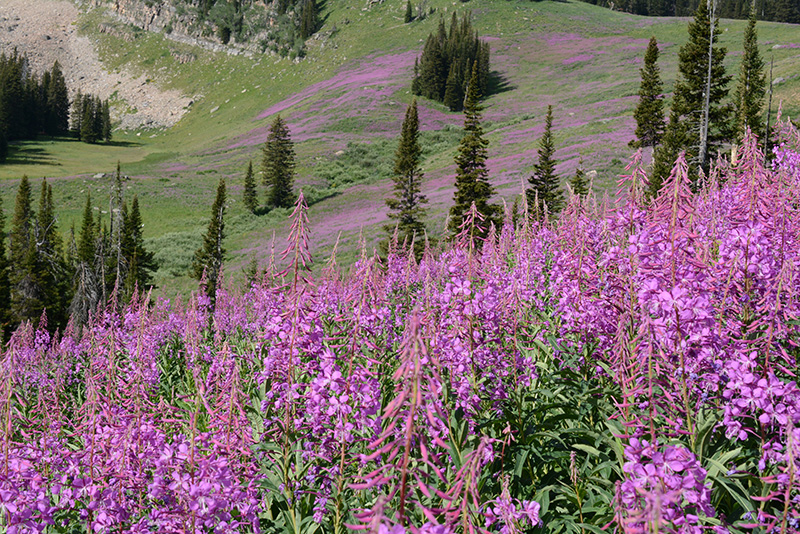
Some of us have made pilgrimages to expansive stands of fireweed; others puzzle over goldenrods and aster look-alikes; and many applaud yet another yellow composite just beginning to bloom along roadsides. Summer isn’t quite over.
Below are some of the final flowers to look for on your hikes and drives throughout the valley. They provide interesting botanical puzzles. Below, we have tried to help you sort them out if you are so inclined. A 10x magnifier helps not only to identify the characteristics of the species, but also to reveal how many bugs and grubs are dependent on our native plants for survival. It is fun to botanize on these last lazy summer days.
Asters and their look-alikes
Taxonomically, “asters” have been split into several different genera over the years. Most of this differentiation is due to molecular studies, and not necessarily easy-to-see field characteristics.
In general, “aster” flower heads display mostly blue, violet, lavender, to white ray flowers surrounding a center of many tiny yellow disc flowers. Leaves slowly become smaller as they alternate up the stem. Overall size of plants and leaves can vary considerably depending on growing conditions.
The bracts that surround the composite “heads” are key to separating the genera. Then focus on hairs, leaves, etc., to get to the species.
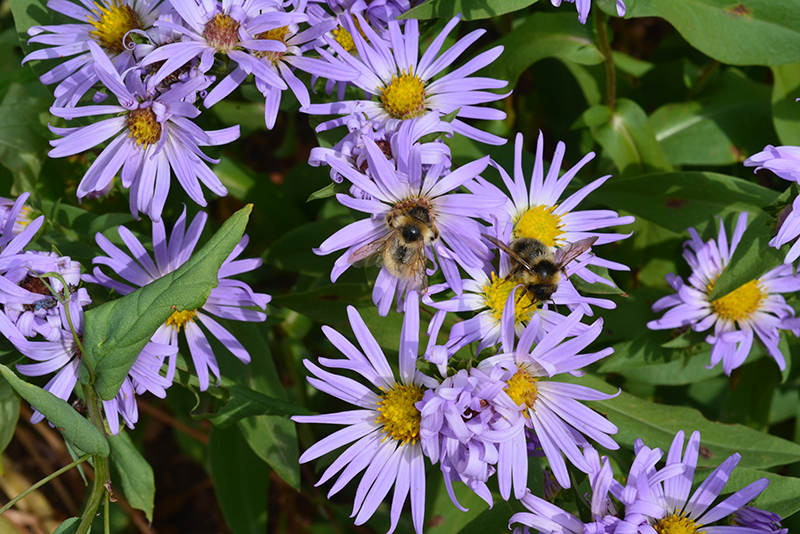
Leafy-bracted Aster – Symphyotrichum foliaceum var. canbyi – is a common aster with large leafy bracts.

The plants vary in size from 1.5-2.5+ feet all. Lower leaves on the upright stems are notably larger than the stem leaves. In this variety, stem leaves often “clasp” the stem.

Note to botany nerds: Dorn lists 3 varieties of S. foliaceum for NW Wyoming. Flora of North America (FNA) says S. f. var. parryi is not here in Wyoming, nor is the very similar S. cusickii.
Alpine Leafy-bracted Aster – S. foliaceum var. apricum – is found at higher elevations, such as the bowls above Ski Lake. These plants grow only about 1’ high and stems are “decumbent”, more sprawling at their base. Bracts are less leafy and are edged in purple.

Eaton’s Aster – Symphyotrichum eatonii – is usually found in moist places such as stream edges and springs.
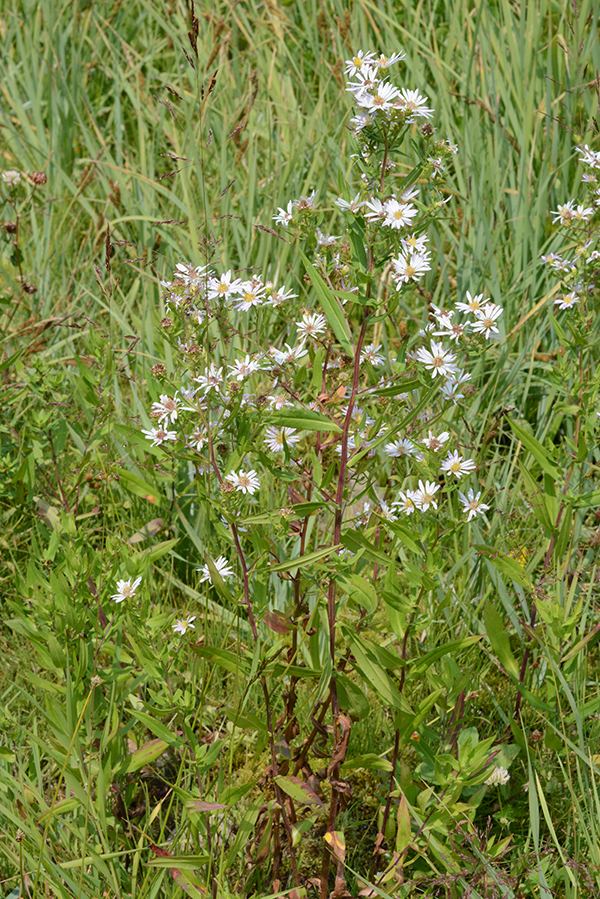
The many white-to-blue small flower heads cover the upper third of more-or-less 3-4’ plants. Their bracts are not foliaceous.
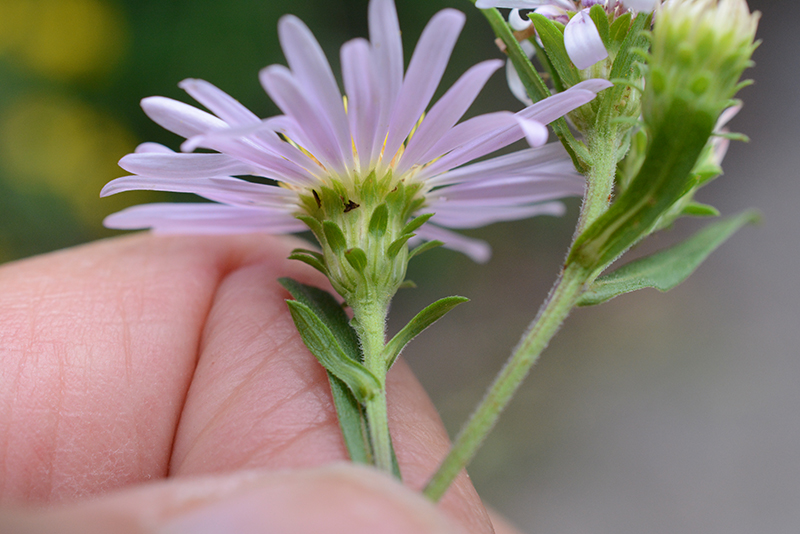
The leaves are long and narrow and are “sessile”, sitting upon but not clasping the stem.

Long-leaved, American, or Mountain Aster – Symphyotrichum ascendens – The many common names of this species are a good indication that this species is noticed by many in different places: the way a popular person may have several nick names among family and friends. Indeed, this plant is native across the western U.S. in a variety of habitats.
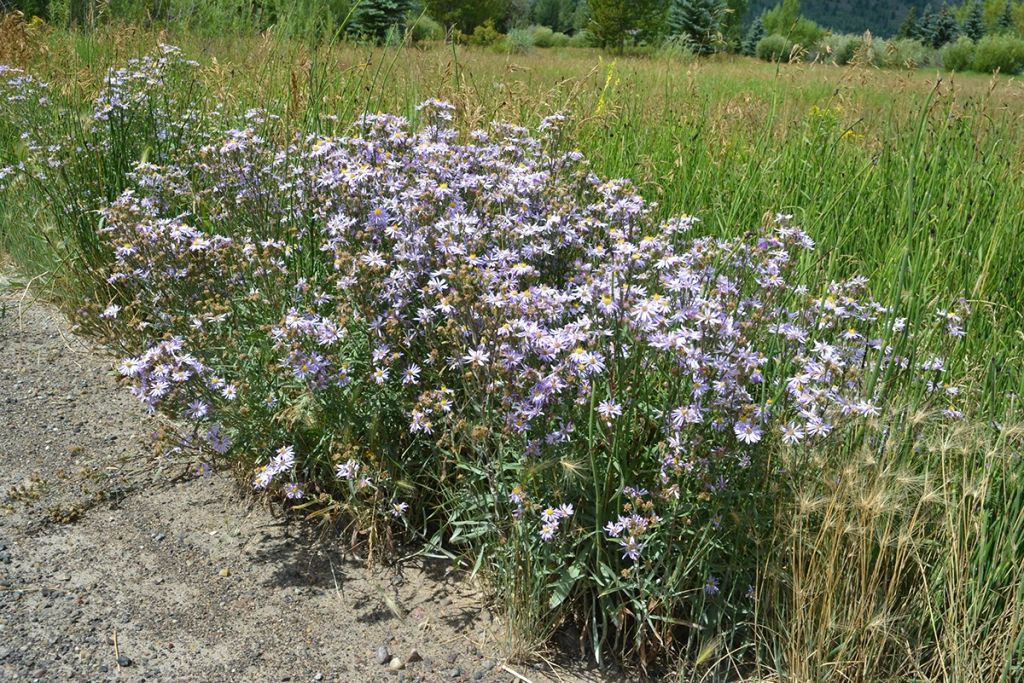
It has been blooming along road and trail sides since early August. The easiest way to know this “typical looking aster” is to examine the leaves: the veins form elongate shapes.
Engelmann Chaffy Aster – Eucephalus engelmannii – is common in the light shade of aspens, forest openings, and moist upper meadows.
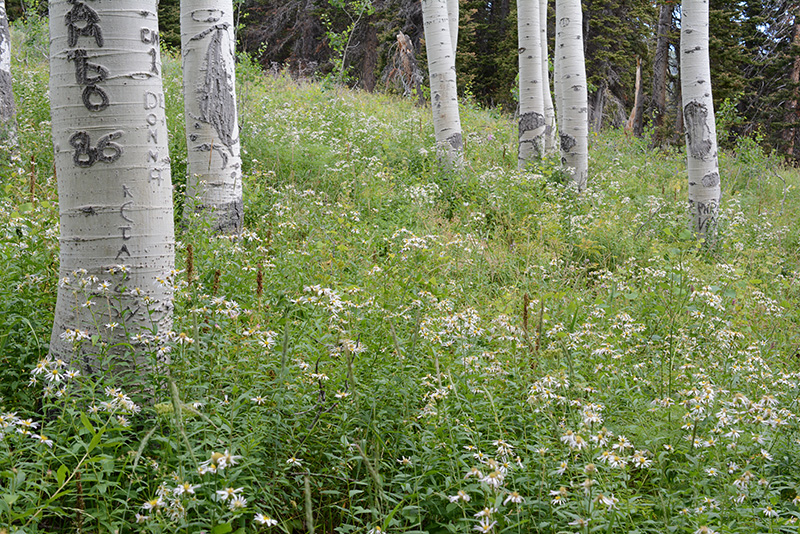

Plants typically grow to 3-4’+ high, and the 3-5” leaves remain similar in size and shape as they spiral up the stem.
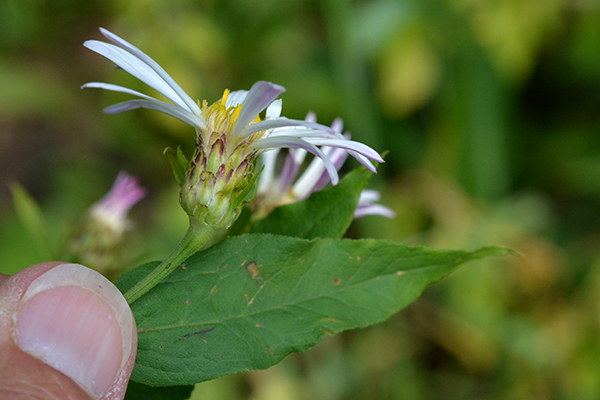
Bracts are tidy: neatly arrayed like shingles on a roof, and are smooth except for the fringed edges. The long white rays are relatively few: 8 -10.
Elegant Chaffy Aster – Eucephalus elegans – is often overlooked as it is only about 1-2′ tall and grows amidst usually thicker foliage of other forbs.

However, the violet-blue ray flowers and purple-tipped bracts substantiate the “elegant” in its name. A species worth looking for.

Blueleaf or Gray Aster – Eucephalus glaucus – was common along the trail to Mt. Elly at the time of writing. The leaves are notably “glaucous” – bluish gray. The ray flowers are lavender to white. The generic name of this species has changed at least four times since 1840 and is now deemed by Flora of North America to be in the Herrickia genus.

Thick-stemmed Aster – Eurybia integrifolia – The bracts not only curve out pointedly, but they and the stems are covered with very sticky glandular hairs.
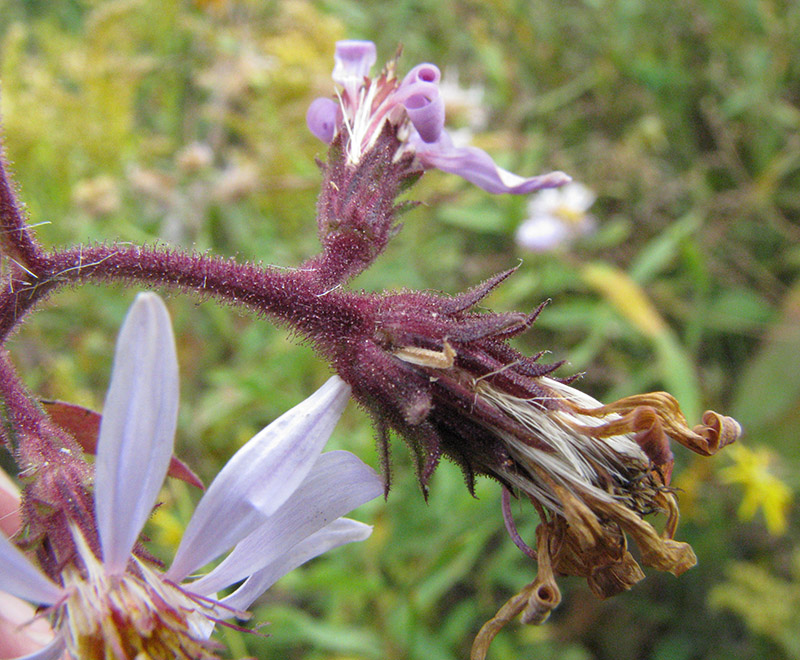
Furthermore, the hefty stems tend to zig-zag.

The leaves are oblong, sessile to clasping, and get smaller as you go up.
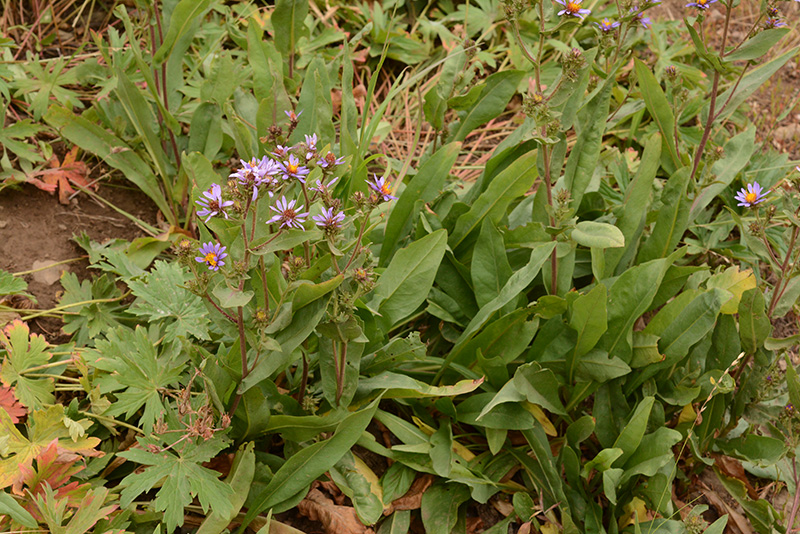
Sticky glands help to protect plants from small marauding insects who get stuck in the miniature forest of hairs. In some cases, such as sticky geraniums, the plant is able to absorb nutrients from the decomposing insects. I am not sure if that is the case here….a research opportunity for a master’s degree student.
Hoary Tansy or Spiny Aster – Machaeranthera canescens – is truly a late-summer into fall bloomer, with spine-tipped, bent-out bracts protecting the violet-blue heads.

Small, stiff, grayish hairs provide the “hoary” or “canescent” look. Plants grow in dry exposed locations, with relatively thin and sparse branches with mostly small, 1-2”, sometimes toothed, leaves. The leaves are spine-tipped, too. A tough plant for sure.
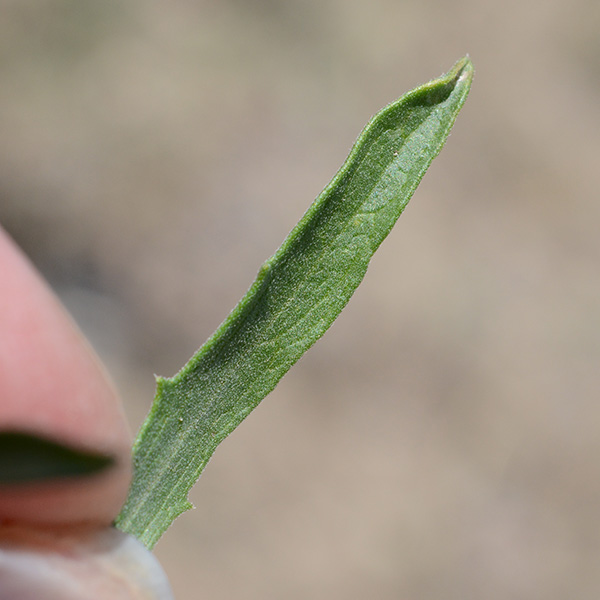
!Not an aster – an exotic invasive!
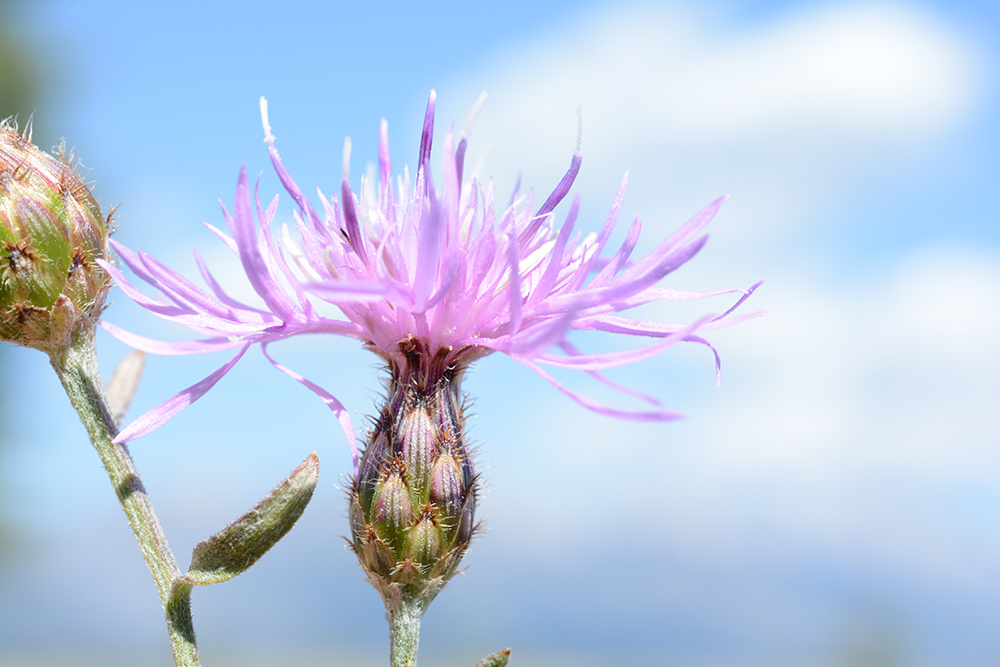
At first glance Spotted Knapweed – Centaurea maculata – might seem an innocent and lovely native aster. It is not. This species came over in the late 1800s in forage and ballast from Eurasia and has spread profusely throughout the U.S.


These are outstanding competitors to our native plants. Considered a biennial or short-lived perennial, each plant can produce a 1000 seeds that readily sprout in spring and fall and remain viable in the soil for five years. Seeds are easily carried by air currents along roads and water down streams. The plants have an advantage because their different life forms keep out the competition in disturbed locations. It was once thought they also had the advantage of cnicin, an allelopathic compound in the plants. However, this was analyzed and found not to be of sufficient toxic levels to affect their rivals in the field. Even without this edge, it outcompetes our natives. More info
Teton Weed and Pest lists Spotted Knapweed as Priority three: regional infestation. It also lists several other knapweeds. Wear gloves when pulling it out as it is known as a carcinogen. Not a good plant.
Goldenrods
First of all, goldenrods do not cause allergies. The pollen is too heavy to fly in the air and up your nostrils. They have a bad rap as their masses of colorful blooms and thick growth often hide inconspicuous wind-pollinated plants that come out about the same time, such Lamb’s-quarters – Chenopodium spp. (Dorn indicates we don’t have ragweed (Ambrosia spp.) in Teton County).
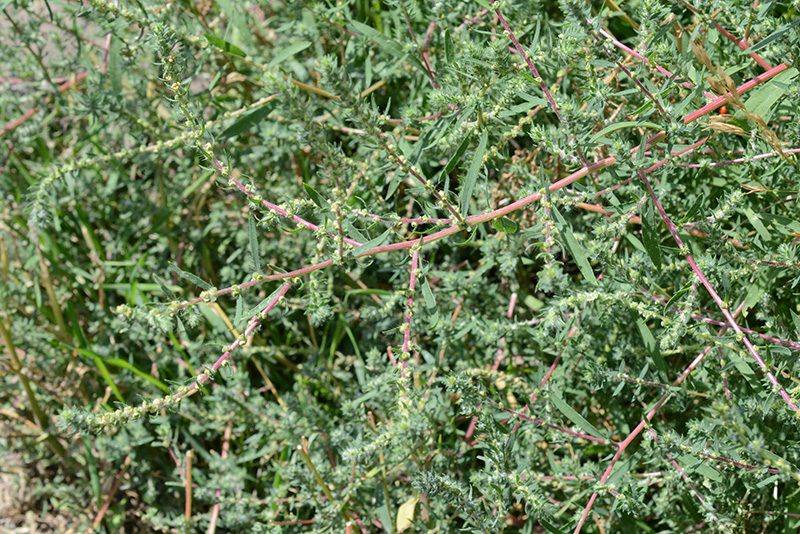
The inconspicuous flowers of lamb’s quarters are hard to see.

Some Sagebrushes – Artemisia spp. – also release pollen upon the wind in the autumn.)
Goldenrods are one of the most important herbaceous plants for small wildlife. Up to 100 insect species thrive on this genus. Butterflies, such as coppers, sulphurs, and hairstreaks, suck up nectar. Bees of all sorts gather protein fats and minerals. Myriad midges lay eggs that form galls. Chickadees and woodpeckers subsequently eat the protein-rich larvae inside. Goldfinches, grosbeaks, and nuthatches eat the seeds. (Reference)
We have eight species of goldenrods (Solidago spp.) in Teton County. The three low-growing species with a bunch of leaves at the base, are relatively easy to identify. The five taller species with leaves that are typically “three-veined” present frustrating puzzles. Their tiny bracts and variable leaf and stem hairs tend to be diagnostic. The widespread Canada Goldenrod is notoriously variable. We will treat the different species more fully in a separate technical ID posting.
For here and now, we emphasize two large species still in bloom that can be separated by the smoothness of their stems and bract details. Note: in any identification endeavor, look at several plants and parts to get the average or typical characteristics.
Rough stems:
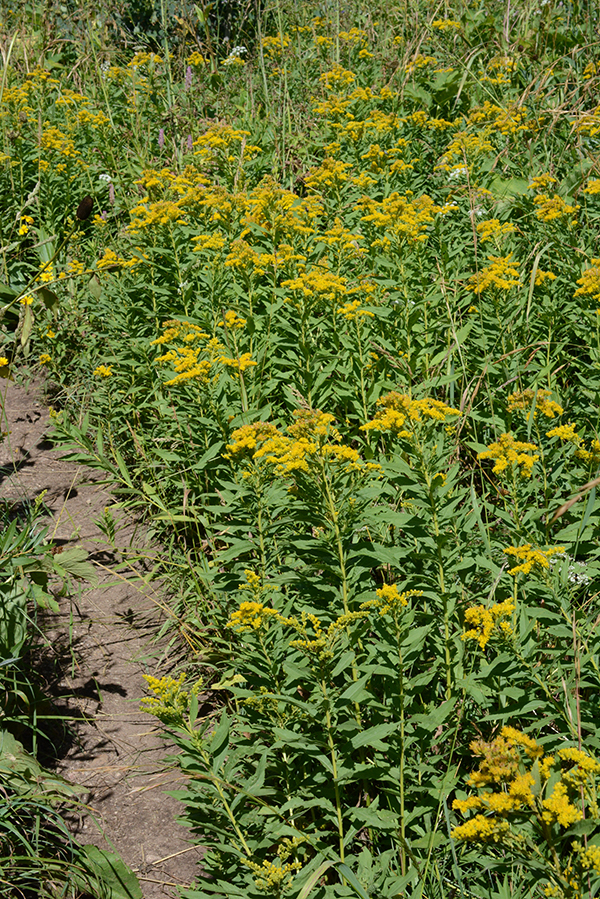
Canada Goldenrod Solidago canadensis – has a disputed natural range. Some people have heard that it is native mostly to the Midwest and Northeast and that Canada Goldenrod has “invaded” the rest of the country. Taxonomic experts report that while indeed it is a robust rhizomatous species, Canada Goldenrod is indigenous throughout much of Canada and the United States. Notably, it was introduced to Europe as an ornamental as early as 1645, where it has become an invasive exotic there. It can be aggressive in one’s garden.

Canada Goldenrod plants grow 3-5’ high, with finely hairy stems. Plentiful leaves are elongate and sharply pointed with saw-toothed edges. Leaves are usually smooth to very finely hairy on top and slightly rough along the three main veins below. As with all goldenrods, there are many small heads of ray and disc flowers. Its miniature bracts are elongate and narrow. Ray flowers number 10-17, averaging 13. Moist places, fields.
Smooth stems:
Giant Goldenrod – Solidago gigantea – looks very similar in its size, leaves, and inflorescence to Canada Goldenrod. The main difference is that below the flower cluster, the stem is smooth and slightly powdery bluish gray (glaucous).

Leaves are smooth up top with only a few hairs on the main veins below.
For botany nerds: there are two other somewhat common look-alikes: Velvet Goldenrod – S. velutina – Stems tend to be hairy, the leaves less toothed, but the ray flowers fewer about 8. Dry locations – I have seen it up Death Canyon. Missouri Goldenrod – S. missouriensis – Stems smooth below flower cluster, leaves usually without teeth, but the leaves can feel rough along edges; the 3 nerves are not that clear. Bracts clearly widest at the base (oblong). Rays 6-10, often 7 or 8. Good luck!
Other composite yellows
Showy Golden-eyes – Viqueria (Heliomeris) multiflora – are lining trails, bike paths and roads with their prolific, cheery yellow flowers. Growing around 2′, stems have opposite, smooth, narrowly oblong leaves 2-4” long.
Note the collective show of ray flowers often darkens toward the center of the flower head. Likely, this slight difference to our eyes is much more dramatic to insects with infrared vision.

The bracts form a simple whorl below the head.
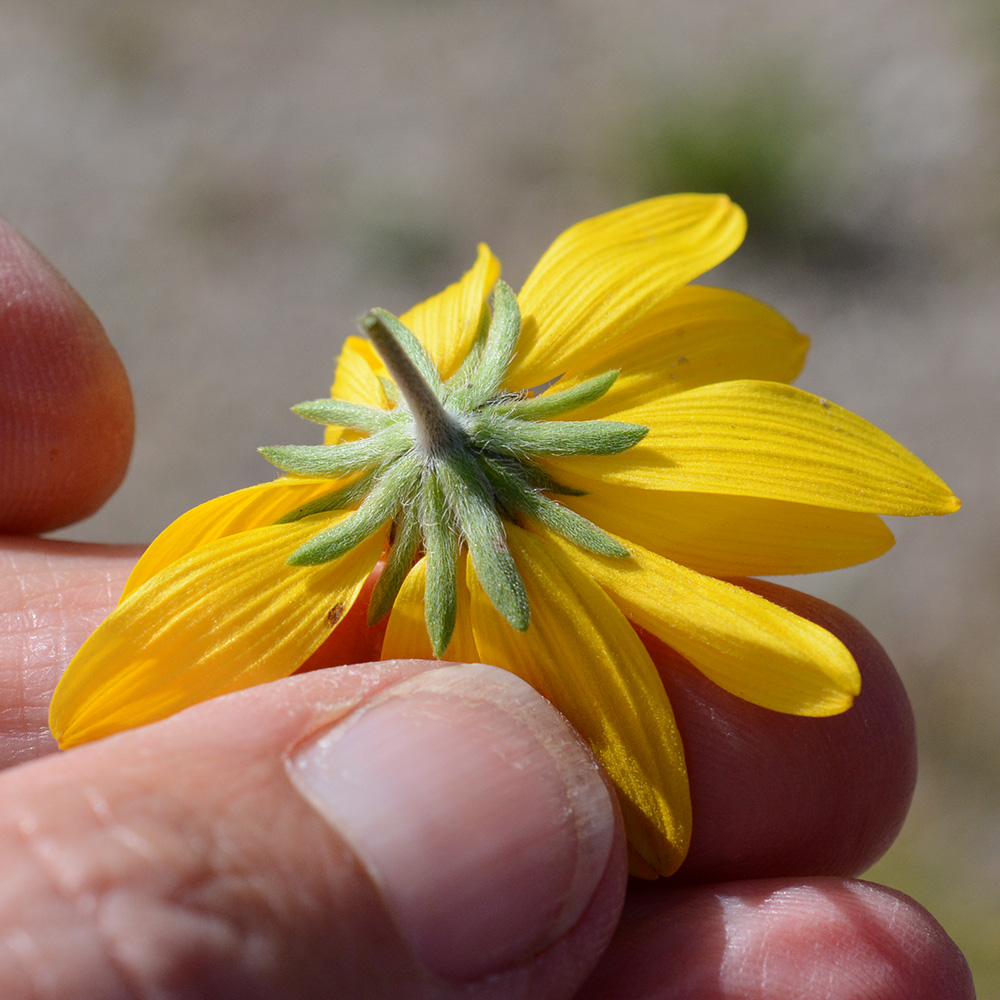
Golden Asters – Heterotheca villosa – are comparatively more humble, untidy looking plants with stubby, finely hairy leaves that alternate up the stems. (The butterfly is Weidmeyer’s Admiral.)

The flowers are bright yellow on slightly long peduncles. This highly variable species ranges from the West Coast to the Midwest mostly in dry sunny locations.
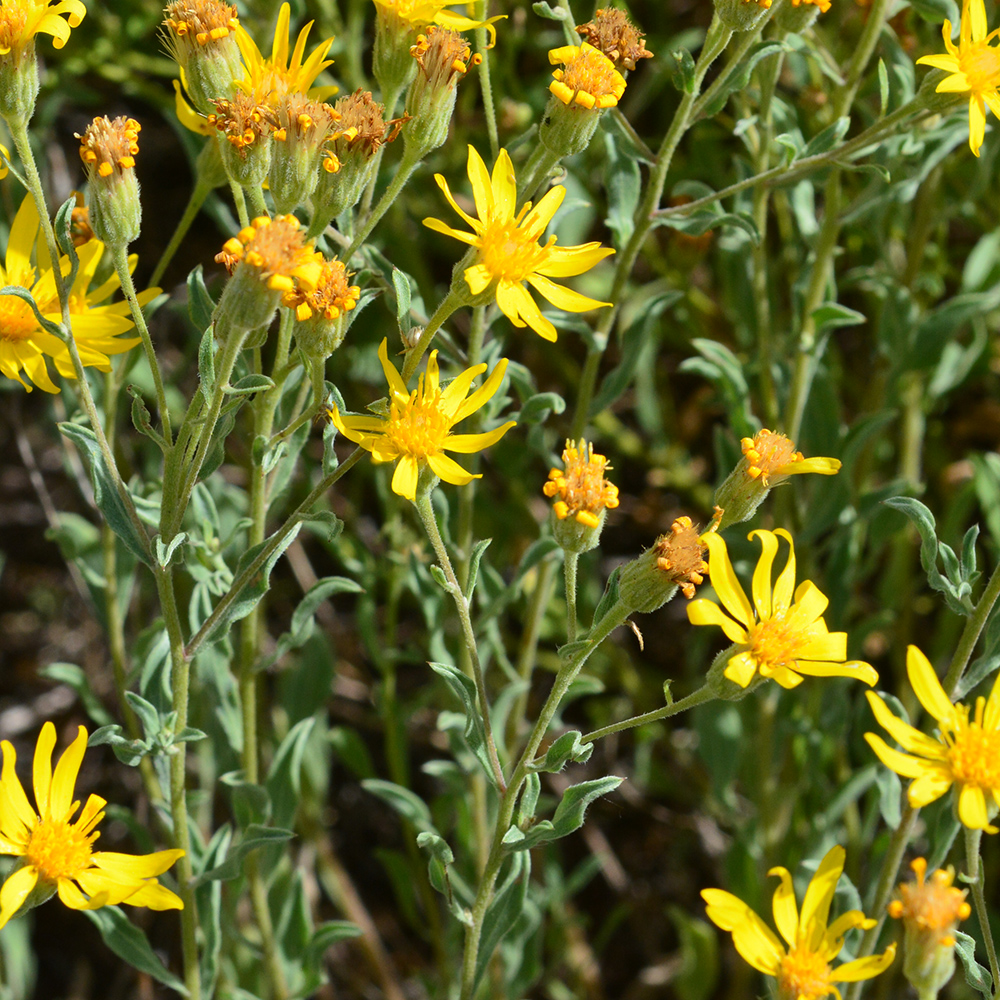
For botany nerds: In Teton County we have two ecotypes or varieties: One: H. v. var. depressa is found around the thermal areas of Yellowstone which I think I have seen around Storm Point. The leaves are clearly hairy. The second: H. v. var. villosa is common, almost weedy, along GTNP roadsides and dry, sandy soils. The oblong stubby leaves and stems have fine hairs lying against the surface (appressed). They mix in with Gumweed along park roads.

Curly-cup Gumweed – Grindelia squarrosa – is one of my favorites for its unique bracts.

Each bract curls back to a point, and they fuse together to form a perfect cup, truly gummy in texture. This species likely originated beyond Teton County but has made its way in along dry road sides and other disturbed places where it seeds readily.

This sticky resinous plant is full of chemicals unpalatable to wildlife but appealing to humans for a variety of medicinal purposes. Caterpillars seem to appreciate the flowers. Plants are about 2′ tall, with alternate, small, oblong, blunt leaves with a few teeth.

Odd-ball yellows
Owl’s-clovers – Orthocaprus spp. – used to be in the Snapdragon or Scrophulariaceae Family, but along with its relatives, paintbrushes (Castilleja) and louseworts (Pedicularis), the genus is now placed in the Broomrape or Orobanche Family. These three genera are hemi-parasites on other plants. Their specialized roots (haustonia) connect with their host’s roots and siphon off nutrients.
Owl’s-clovers are annuals that grow 6-18″ high, have small pouched flowers and small leaves . Hosts are unknown. We have two species in Teton County:
Yellow Owl’s-clover – Orthocaprus luteus – is usually single stemmed and the hairs stick out.

Tolmie’s Owl’s-clover – Orthocarpus tolmiei – grows along the trail to Ski Lake and above. It usually has several branches and the hairs are mostly pressed against the stems.
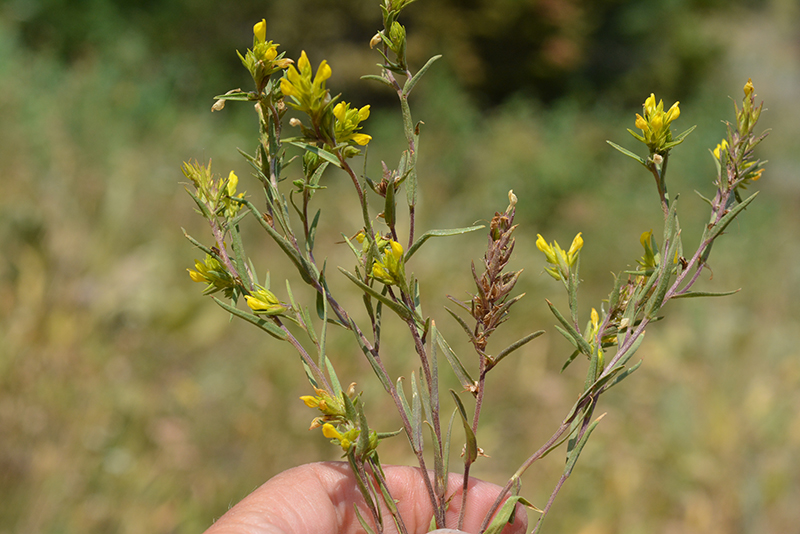
Finally
Mountain Bog Gentians – Gentiana calycosa – form patches of blue often on rocky slopes or talus at higher elevations, such as along the trail south of Teton Pass. The stiff, deep-green, shiny leaves are opposite, rounded, and very tidy looking.

For half an hour I watched various bumblebees dive into the tubular flowers, wriggling down while the anthers shed pollen onto their hairy bee bodies. The bees follow nectar guides to the base of the flower. Just below are five holes that lead to wells of nectar reachable only with a long proboscis (tongue).
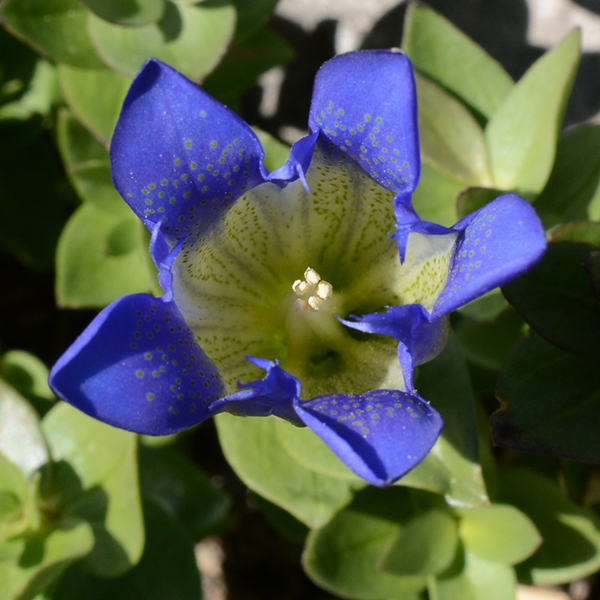
I noticed the bees back out, appearing to clean their long proboscis. In researching further, I read that a bumblebee has a long hairy tongue that laps up nectar. The tongue or proboscis is enclosed by two mandibles that fold under the bee’s body when it flies.
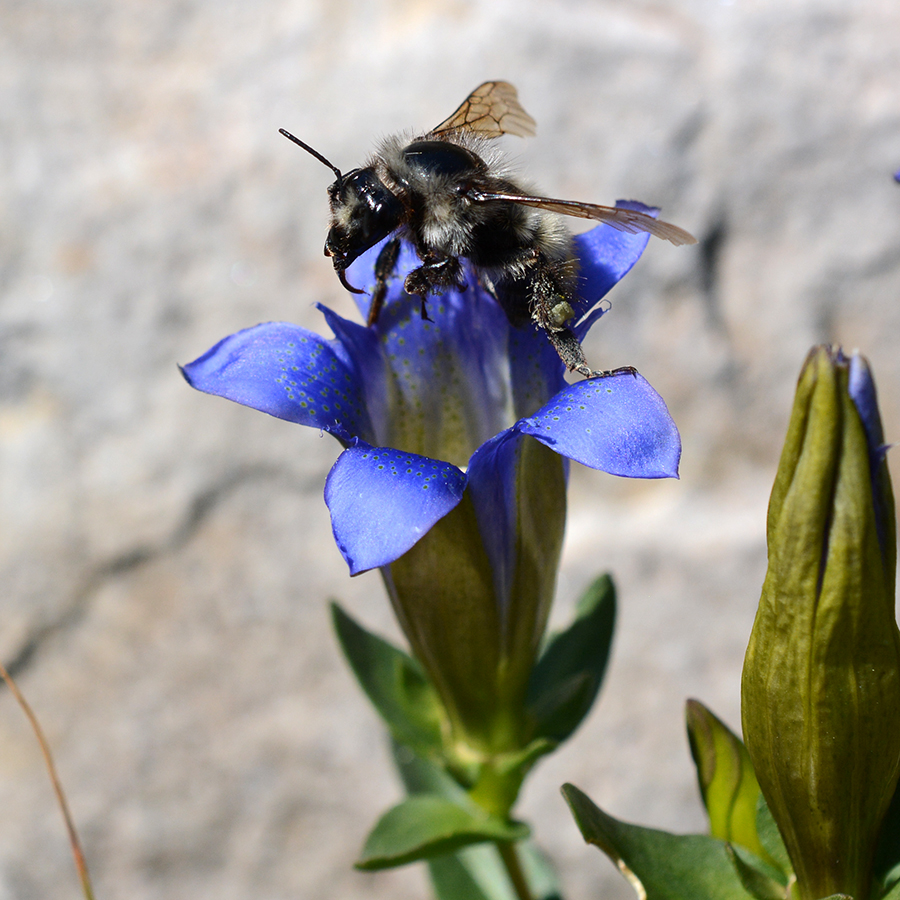
Watching longer, I noticed that some bees tumbled off the flower. Then they righted themselves and flew to another open flower, where a stigma maybe positioned to rub off the pollen to start the seed-making process. Very cool action between plants and insects.

While flowers fade, fruits form (a subject for another posting), and leaves will turn wonderful colors before winter arrives. Keep on botanizing!
Frances Clark, Wilson, WY
August 28, 2022



Oh man all my favorites and my late-season identification boogies. Thanks for putting together some descriptions of our asters and goldenrods! And I loooove the gentians!